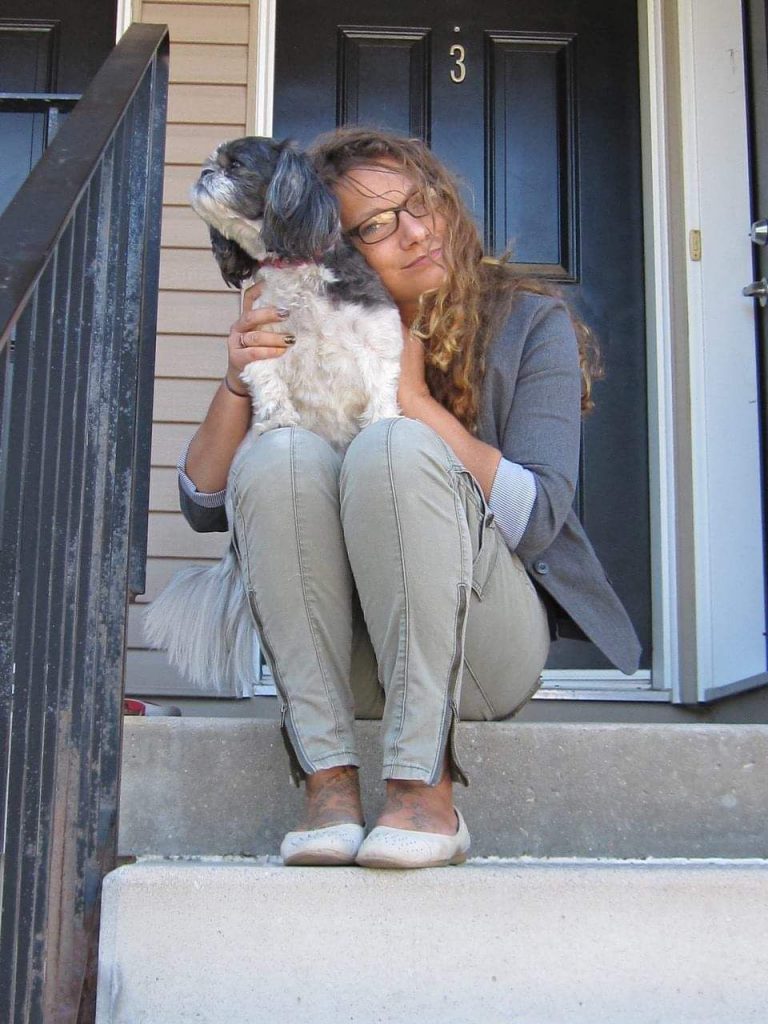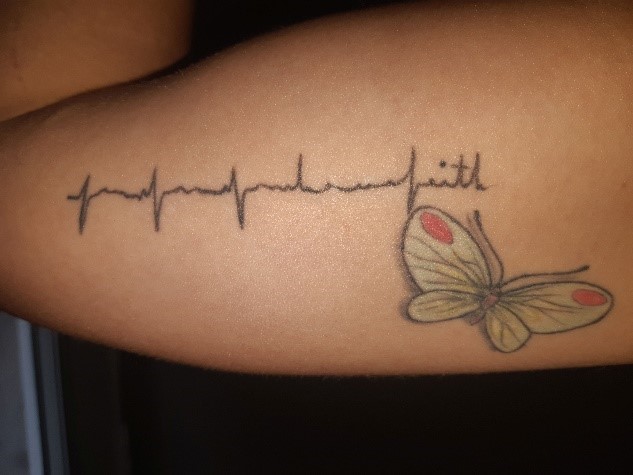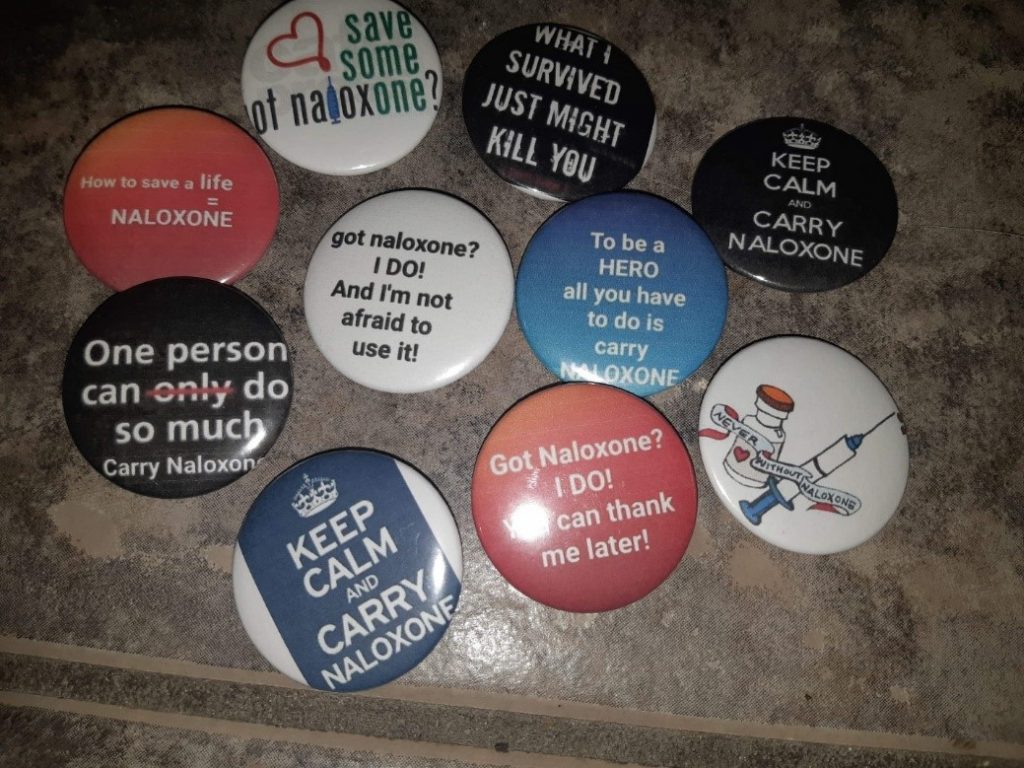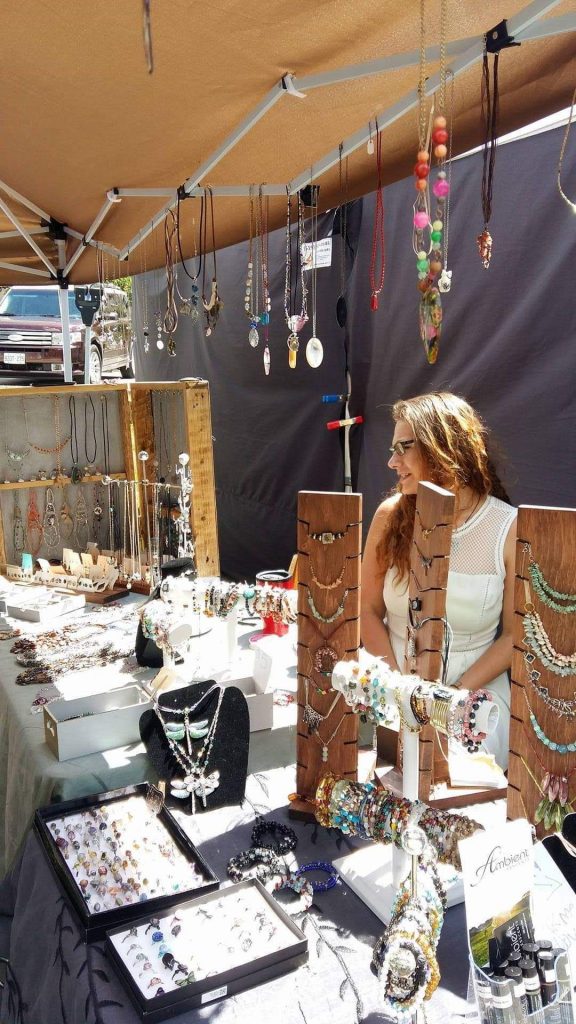From accidental opioid dependency to advocate

Charlotte with her dog Mia, her true best friend. 
Charlotte’s tattoo is her ECG reading when she emerged from a near fatal coma, with her father’s words “have faith” incorporated into the graph lines.
Charlotte Munro bears a tattoo of her ECG reading from when she emerged from a near fatal coma. It’s a talisman of sorts, with the phrase “have faith” incorporated into the graph lines.
“When doctors didn’t have a prognosis to tell my parents and discussions were about removing me from life support, my dad persisted each day to give it one more day, and repeatedly said “have faith”,” says Charlotte. “After two weeks, on Christmas Eve 2014, I came out of the coma.”
Her brush with death was the beginning of the end of a nightmare that started with a prescription for a fentanyl patch for pain which plunged her into accidental opioid dependency. Now Charlotte is applying her lived experience to help others who use opioids as a patient partner with ODPRN, an OSSU research centre, which focuses on drug-policy research, especially related to the opioid epidemic. She is also an advocate for vulnerable people and for mental health.
A member of ODPRN’s Lived Experience Advisory Group, Charlotte provided a patient perspective, advice and insights into the Opioid Mortality Surveillance Report issued in June 2019. Living in Stratford, Ontario, she has a unique small town viewpoint, ensuring that different communities are represented.
“I really enjoy being part of the group and it’s giving me a sense of purpose after my situation, which was kind of horrible. It’s making something good out of something bad,” says Charlotte. “I want to stay involved and see changes made so fewer families suffer. Because of my experience, I want to help with that.”
Giving back, helping others and telling her story are central to who she is now.
Charlotte’s story
It was an undiagnosed medical condition that sent Charlotte down the rabbit hole of opioid dependency which took her to the brink of death and back.
About 10 years ago, she experienced bone pain in her legs which was diagnosed as rheumatoid arthritis. She was prescribed a fentanyl patch which caused profuse sweating so was switched to hydromorphone, another opioid used to treat pain.
It was later discovered to be avascular necrosis, a painful, serious condition in which bone dies from lack of oxygen.
A chance encounter on a city bus on her way home from work changed everything after she gave a young woman bus fare. They started talking and discovered they were both on dilaudid for leg pain and in the case of the other woman, knee surgery.
“That’s when things changed,” says Charlotte. “I was very naïve, easily influenced, gullible and insecure.”
Charlotte and the woman became immediate friends, a friendship that Charlotte later found to be destructive as she taught Charlotte how to get high off her medication and introduced her to others who took advantage of her access to prescription opioids.
Eventually, the young woman developed endocarditis, a life-threatening infection of the heart, and was taken off life support after only three days. She and Charlotte were 23.
“The people who were stealing my drugs were in the same addiction I was. We were in the same hell but what led us there was different.”
When she eventually went off her medication, she found out her monthly 180 pill prescriptions were worth $7200 on the street.
Seeking a way out, Charlotte moved to a small Ontario town near Lake Huron in 2014 where she stopped opioids entirely for six weeks before starting methadone to help wean her off opioid dependency. However, her leg and bone pain continued and she felt progressively worse. She was eventually admitted to hospital in a coma with endocarditis.
“I was in a coma for two weeks, during which my organs started to shut down. My family thought I was going to die and started making funeral arrangements.”
When she awoke on Christmas Eve surrounded by family, everyone felt it was a miracle.
“I was healed, mind, body and soul,” says Charlotte.
She thinks a lot about the girl who didn’t make it and what might have been.
“It kind of makes you wonder, what if that girl didn’t have the plug pulled. Was she written off because she was labelled an ‘addict’ and didn’t have her family there questioning the medical team? I think of her a lot.”
The present
Happily living in Stratford, Charlotte, now 33, is a child and youth worker and has started volunteering to slowly get back into a regular routine. Last year, she was hired by a local organization as a support worker for people with intellectual disabilities. She also provides private respite for people who live at home, teaching them how to take the bus, do volunteer work and get out into the community.
She credits a supportive counsellor, subsidized housing and a mentor who checked in with her regularly as key to moving forward.
Determination and being open are building blocks to getting her life back.
“I did self-improvement, anything and everything I could to better myself,” she says. “I developed my self-worth and I think that’s what was missing, that I didn’t love myself. I think totally differently now.”
That includes exploring her creative side, which has led to a jewelry business, Mia and Munro, named after Charlotte’s dog Mia, as well as photography, clay work, button and magnet making and more. An active community volunteer, she sits on a local board, fundraises for a women’s shelter and for a city councillor’s autism walk, and also supports a local homeless organization.
Now an advocate for naloxone use [medication that reverses opioid overdoses], Charlotte shares her experience rather than feeling ashamed. She offers support for people and their families who are struggling, giving them hope that there is a way out.
“The coma changed my life. I don’t have any negative talk or anything. I see things differently. My pain is gone and I don’t take any medication now.”
Her ECG shows she is clear and there is no need for further monitoring.
“Before all this started, I was not in a good place. Whether I took advantage of my doctor which led my down this road, I don’t know. I had no idea what opioids were.”
“All I can do is be so thankful and grateful that I am here and not another statistic, but it’s hard to recognize that without realizing many didn’t make it.”
Contributing her lived experience through ODPRN and telling her story helps her heal.
“I am really feeling blessed that things have turned around. I have a great life in Stratford. It was really great to move here.”
Read related stories from ODPRN and Healthy Debate at The Opioid Chapters.
As told to Kim Barnhardt.
Words of wisdom
Charlotte has some words of experience for people who are recovering, for their families and health care professionals:
“Some people fall down multiple times and you can’t really give up on them. If it happened to me and I can get out of it, think about the great potential these other people can have.”
- Don’t leave your doctor’s office with questions. I feel like I wasn’t properly educated on what I was given [opioids for pain]. Maybe counselling before the opiates would have been necessary.
- Love yourself. The things I was doing were pretty bad, pretty risky behavior. Life is too short. When you are in that kind of addiction you don’t think of that. Your focus is on getting the next fix. It changes you.
- Family members – Stay involved, take advantage of counselling for family members. Be a support. Check in. People want to know that they are cared about.
- Barriers – Stigma and labelling people who use opioids are barriers to recovery and acceptance and even day-to-day activities.
- Recovery – It’s important to know what support networks exist such as counselling and other supports, creative group pursuits so that you can get out and do social things with people in the same boat. Fellowship is important.

